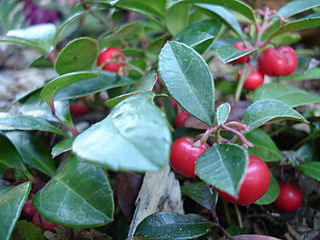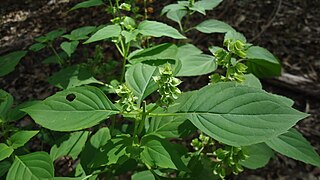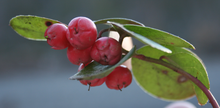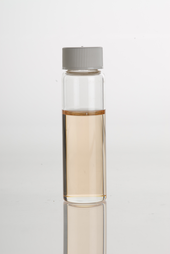
Listerine is an American brand of antiseptic mouthwash that is promoted with the slogan "Kills germs that cause bad breath". Named after Joseph Lister, who pioneered antiseptic surgery at the Glasgow Royal Infirmary in Scotland, Listerine was developed in 1879 by Joseph Lawrence, a chemist in St. Louis, Missouri.

Spearmint, also known as garden mint, common mint, lamb mint and mackerel mint, is a species of mint, Mentha spicata (, native to Europe and southern temperate Asia, extending from Ireland in the west to southern China in the east. It is naturalized in many other temperate parts of the world, including northern and southern Africa, North America, and South America. It is used as a flavouring in food and herbal teas. The aromatic oil, called oil of spearmint, is also used as a flavoring and sometimes as a scent.

Tarragon, also known as estragon, is a species of perennial herb in the family Asteraceae. It is widespread in the wild across much of Eurasia and North America and is cultivated for culinary and medicinal purposes.

An essential oil is a concentrated hydrophobic liquid containing volatile chemical compounds from plants. Essential oils are also known as volatile oils, ethereal oils, aetheroleum, or simply as the oil of the plant from which they were extracted, such as oil of clove. An essential oil is essential in the sense that it contains the essence of the plant's fragrance—the characteristic fragrance of the plant from which it is derived. The term "essential" used here does not mean indispensable or usable by the human body, as with the terms essential amino acid or essential fatty acid, which are so called because they are nutritionally required by a living organism.

Methyl salicylate (oil of wintergreen or wintergreen oil) is an organic compound with the formula C8H8O3. It is the methyl ester of salicylic acid. It is a colorless, viscous liquid with a sweet, fruity odor reminiscent of root beer (in which it is used as a flavoring), but often associatively called "minty", as it is an ingredient in mint candies. It is produced by many species of plants, particularly wintergreens. It is also produced synthetically, used as a fragrance and as a flavoring agent.

Gaultheria procumbens, also called the eastern teaberry, the checkerberry, the boxberry, or the American wintergreen, is a species of Gaultheria native to northeastern North America from Newfoundland west to southeastern Manitoba, and south to Alabama. It is a member of the Ericaceae.
Nutmeg oil is a volatile essential oil from nutmeg. The oil is colorless or light yellow and smells and tastes of nutmeg. It contains numerous components of interest to the oleochemical industry. The essential oil consists of approximately 90% terpene hydrocarbons. Prominent components are sabinene, α-pinene, β-pinene, and limonene. A major oxygen-containing component is terpinen-4-ol. The oil also contains small amounts of various phenolic compounds and aromatic ethers, e.g. myristicin, elemicin, safrole, and methyl eugenol. The phenolic fraction is considered main contributor to the characteristic nutmeg odor. However, in spite of the low oil content, the characteristic composition of nutmeg oil makes it a valuable product for food, cosmetic and pharmaceutical industries. Therefore, an improved process for its extraction would be of industrial interest.

Rose oil is the essential oil extracted from the petals of various types of rose. Rose ottos are extracted through steam distillation, while rose absolutes are obtained through solvent extraction, the absolute being used more commonly in perfumery. The production technique originated in Greater Iran. Even with their high price and the advent of organic synthesis, rose oils are still perhaps the most widely used essential oil in perfumery.

Eucalyptol is a monoterpenoid colorless liquid, and a bicyclic ether. It has a fresh camphor-like odor and a spicy, cooling taste. It is insoluble in water, but miscible with organic solvents. Eucalyptol makes up about 70–90% of eucalyptus oil. Eucalyptol forms crystalline adducts with hydrohalic acids, o-cresol, resorcinol, and phosphoric acid. Formation of these adducts is useful for purification.

Certs was a brand of breath mint that was noted for the frequent use of "two mints in one" in its marketing. The original "classic mints" were disc-shaped without a hole and sold in roll packaging similar to Life Savers and Polo. Certs was one of the first mints to be nationally marketed in the United States and has been a fixture at American drug stores and convenience stores since its debut on the market in 1956. It was discontinued in 2018, possibly for having partially hydrogenated cottonseed oil, which is not allowed as an ingredient in food sold in the United States since then.

Eucalyptus oil is the generic name for distilled oil from the leaf of Eucalyptus, a genus of the plant family Myrtaceae native to Australia and cultivated worldwide. Eucalyptus oil has a history of wide application, as a pharmaceutical, antiseptic, repellent, flavouring, fragrance and industrial uses. The leaves of selected Eucalyptus species are steam distilled to extract eucalyptus oil.
Wintergreen is a group of aromatic plants, many in the genus Gaultheria.

Plant oils or vegetable oils are oils derived from plant sources, as opposed to animal fats or petroleum. There are three primary types of plant oil, differing both the means of extracting the relevant parts of the plant, and in the nature of the resulting oil:
- Vegetable fats and oils were historically extracted by putting part of the plant under pressure, squeezing out the oil.
- Macerated oils consist of a base oil to which parts of plants are added.
- Essential oils are composed of volatile aromatic compounds, extracted from plants by distillation.
Gaultheria humifusa is a species of shrub in the heath family which is known by the common names alpine wintergreen and alpine spicy wintergreen. It is native to western North America, from British Columbia to California to Colorado, where it grows in moist subalpine mountain forests. It is a low, spreading shrub which may be quite small, forming flat patches on the ground or amongst rock and leaf litter. The stems are less than 20 cm (7.9 in) in length and have small oval-shaped leaves 1 to 2 cm long. It bears solitary bell-shaped flowers with white to light pink corollas and golden anthers which, after pollination, mature into bright to dull red berrylike fruit capsules. The leaves and fruit of Gaultheria humifusa are edible.

Gaultheria ovatifolia is a species of shrub in the heath family which is known by the common names western teaberry, Oregon spicy wintergreen, and slender wintergreen. It is native to western North America from British Columbia to California, where it grows in high mountain forests.

Ocimum campechianum is a plant species in the family Lamiaceae, widespread across Mexico, Central America, South America, the West Indies, and Florida.

Bergamot essential oil is a cold-pressed essential oil produced by cells inside the rind of a bergamot orange fruit. It is a common flavoring and top note in perfumes. The scent of bergamot essential oil is similar to a sweet light orange peel oil with a floral note.

Thymus zygis is a type of flowering plant in the family Lamiaceae native to the Iberian Peninsula and northern Morocco.
Wintergreen soda was a flavored carbonated beverage once popular in North America. The flavoring that was added to wintergreen soda water was "nominally made out of teaberry leaves, or wintergreen." Other regional common names used to describe Gaultheria procumbens included mountain berries, wintergreen plums, or checked berries. Wintergreen soda may have originally been a homemade foodstuff but was ultimately one of the many flavors listed in the catalogs of flavoring companies serving late 19th-century soda fountain proprietors.

















